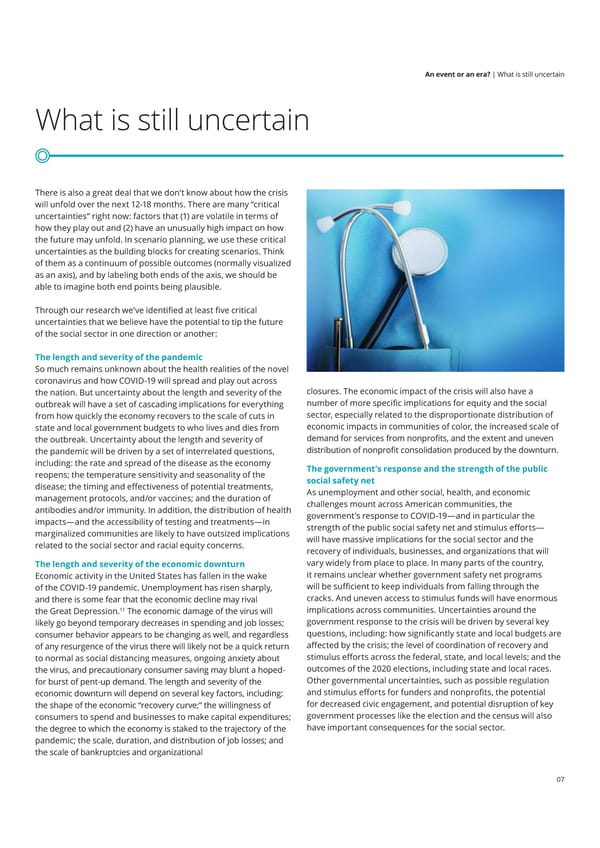An event or an era? | What is still uncertain What is still uncertain There is also a great deal that we don’t know about how the crisis will unfold over the next 12-18 months. There are many “critical uncertainties” right now: factors that (1) are volatile in terms of how they play out and (2) have an unusually high impact on how the future may unfold. In scenario planning, we use these critical uncertainties as the building blocks for creating scenarios. Think of them as a continuum of possible outcomes (normally visualized as an axis), and by labeling both ends of the axis, we should be able to imagine both end points being plausible. Through our research we’ve identified at least five critical uncertainties that we believe have the potential to tip the future of the social sector in one direction or another: The length and severity of the pandemic So much remains unknown about the health realities of the novel coronavirus and how COVID-19 will spread and play out across the nation. But uncertainty about the length and severity of the closures. The economic impact of the crisis will also have a outbreak will have a set of cascading implications for everything number of more specific implications for equity and the social from how quickly the economy recovers to the scale of cuts in sector, especially related to the disproportionate distribution of state and local government budgets to who lives and dies from economic impacts in communities of color, the increased scale of the outbreak. Uncertainty about the length and severity of demand for services from nonprofits, and the extent and uneven the pandemic will be driven by a set of interrelated questions, distribution of nonprofit consolidation produced by the downturn. including: the rate and spread of the disease as the economy The government’s response and the strength of the public reopens; the temperature sensitivity and seasonality of the social safety net disease; the timing and effectiveness of potential treatments, As unemployment and other social, health, and economic management protocols, and/or vaccines; and the duration of challenges mount across American communities, the antibodies and/or immunity. In addition, the distribution of health government’s response to COVID-19—and in particular the impacts—and the accessibility of testing and treatments—in strength of the public social safety net and stimulus efforts— marginalized communities are likely to have outsized implications will have massive implications for the social sector and the related to the social sector and racial equity concerns. recovery of individuals, businesses, and organizations that will The length and severity of the economic downturn vary widely from place to place. In many parts of the country, Economic activity in the United States has fallen in the wake it remains unclear whether government safety net programs of the COVID-19 pandemic. Unemployment has risen sharply, will be sufficient to keep individuals from falling through the and there is some fear that the economic decline may rival cracks. And uneven access to stimulus funds will have enormous 11 implications across communities. Uncertainties around the the Great Depression. The economic damage of the virus will likely go beyond temporary decreases in spending and job losses; government response to the crisis will be driven by several key consumer behavior appears to be changing as well, and regardless questions, including: how significantly state and local budgets are of any resurgence of the virus there will likely not be a quick return affected by the crisis; the level of coordination of recovery and to normal as social distancing measures, ongoing anxiety about stimulus efforts across the federal, state, and local levels; and the the virus, and precautionary consumer saving may blunt a hoped- outcomes of the 2020 elections, including state and local races. for burst of pent-up demand. The length and severity of the Other governmental uncertainties, such as possible regulation economic downturn will depend on several key factors, including: and stimulus efforts for funders and nonprofits, the potential the shape of the economic “recovery curve;” the willingness of for decreased civic engagement, and potential disruption of key consumers to spend and businesses to make capital expenditures; government processes like the election and the census will also the degree to which the economy is staked to the trajectory of the have important consequences for the social sector. pandemic; the scale, duration, and distribution of job losses; and the scale of bankruptcies and organizational 07
 US Deloitte Monitor Institute Page 6 Page 8
US Deloitte Monitor Institute Page 6 Page 8